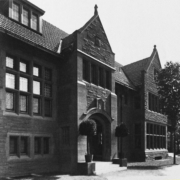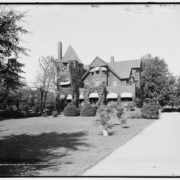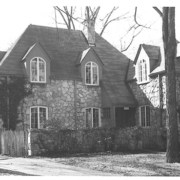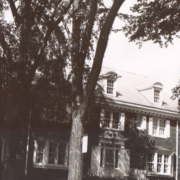Historical Architecture of Grosse Pointe – 15 Moorland
Last week we featured some of the homes in Grosse Pointe that use Indiana limestone as an integral part of the design, either as cladding or as trim. Indiana limestone has helped build a community and has played a massive part in the architectural history of Grosse Pointe. It remains permanently on display on some of the finest homes and public buildings in the area – an “aristocrat building material” that made such a difference to the composition of a home. This week we jump forward into the 1950’s to review a home designed by contemporary architect Anne (Krebs) Crane, welcome to 15 Moorland. Ms. Crane was responsible for the design of several outstanding modern properties in Grosse Pointe from the 1950’s through to the beginning of the 1990’s.
Anne Crane was born in Belleville Illinois, in 1924. She graduated from the University of Illinois School of Architecture, in 1946. She moved to Grosse Pointe, in 1950, where she would reside for 62 years. When she moved to the area, we understand Ms. Crane wanted to further her studies at Cranbrook under the tutorship of internationally renowned modernist architect Eliel Saarinen. Sadly Mr. Saarinen passed in the summer of 1950, so Anne Crane accepted a job offer from world famous designer Minoru Yamasaki, who was a follower of her work.
Yamasaki employed Anne Crane in his prestigious firm – Hellmuth, Yamasaki and Leinweber from 1950-1954. Minoru Yamasaki had a stellar career and became one of the most respected modernist artists in the United States. The firm had offices in Detroit and St. Louis – Anne was a registered architect in Illinois, Missouri and Michigan. One of Anne’s colleagues at the firm was William Kessler – an extremely talented modernist architect who designed several homes in Grosse Pointe and resided in the community. It is reported the two designers became lifelong friends.
In 1955, Anne Crane, after leaving the firm of Hellmuth, Yamasaki and Leinweber, partnered with Lester Fader to form the firm of Krebs and Fader. Together they created numerous commercial buildings and modern residences throughout Metro Detroit and the United States. Their work incorporated widespread building techniques that were popular during the mid-century modern era – extensive use of glass, open floors plans, and accordion roofs (the property below was designed by Krebs and Fader – located in Metro Detroit: courtesy of the Detroit News). Crane’s business partner, Les Fader, was a respected contemporary architect. In 1959, he joined the Department of Architecture at the University of Michigan, where he taught until he became a professor emeritus, in 1992.
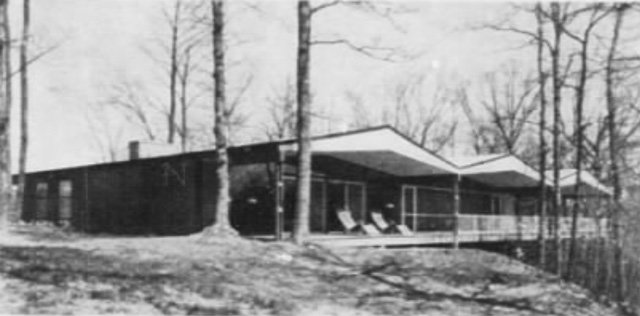
After Anne Crane parted company with Les Fader, around 1958, she set up a new practice in conjunction with her husband, George C. Crane, called Crane Construction Company. The couple was responsible for the design and build of several distinctive homes in Grosse Pointe, including 15 Moorland in Grosse Pointe Shores. Upon completion the property became the couple’s home.
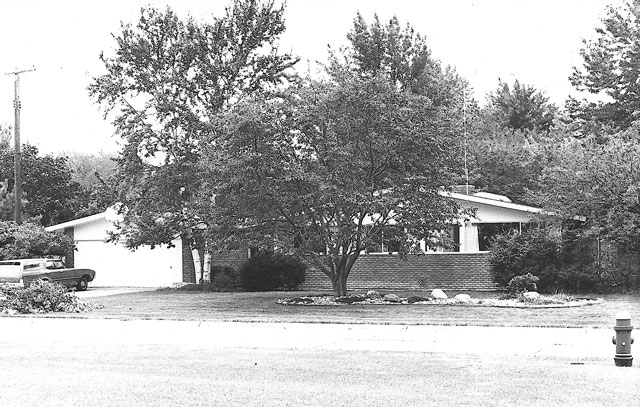
The 3,009 sq ft ranch style residence was completed, in 1958. It is an excellent example of a Mid-century Modern home that was designed to provide the maximum amount of space. The front elevation is dominated by the zig zag roof that encompasses the house and the garage. Meanwhile, the entrance to the house is at the side through a planted courtyard located between the house and the garage. The glass walled entrance courtyard also links the main residence to the garage. At the rear of the garage is an attached art studio and an office (both added in 1960) that leads, through a sliding glass door, to a paved terrace, and the Japanese inspired garden that once featured pots and a border of crushed stone under a wide overhang. Source and image: Detroit News, July 1958.
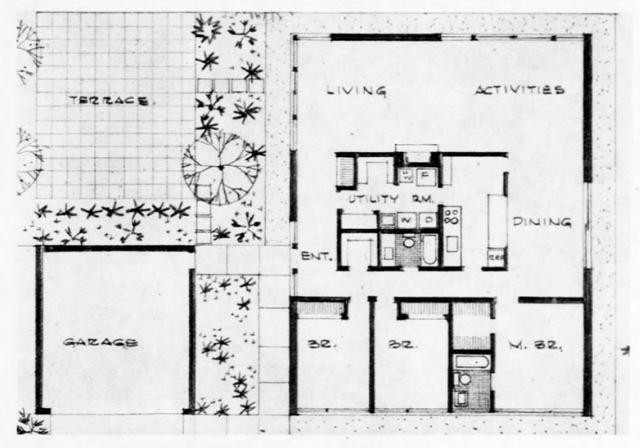
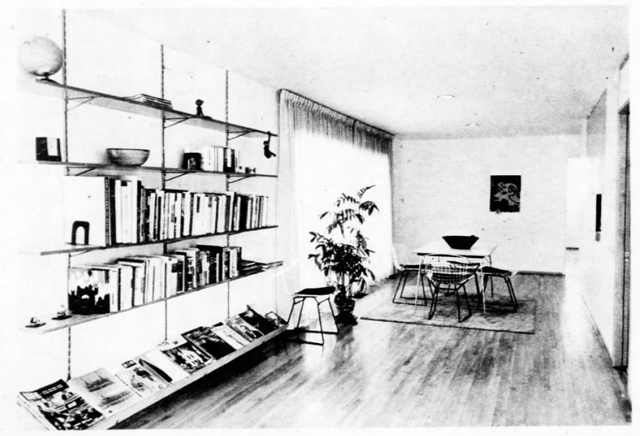
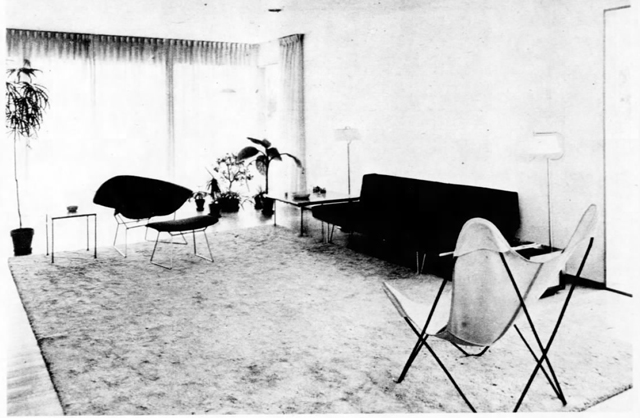

Inside, the house has a modern open floor plan that winds around a central core where the utilities are grouped. One room stretches into another to create a cool, white, and airy feeling in the property. Within the central core is the skylighted kitchen, skylighted bathroom, heater room, closets, and the fireplace for the living room. It is reported this configuration was created for easy upkeep and flexible room use. The floor plan includes a spacious 38’ x 17’ sq ft living room, which leads to the 15’ x 20’ sq ft dining room. The three bedrooms are located at the front of the house, also accessed from the central core. Meanwhile, the kitchen, when the property was built, had white laminated plastic counters, pale birch cabinets and a black-spattered white vinyl floor. According to the article in the Detroit News, “the chief feature was the all-in-one kitchen center – in one appliance, under nine feet in length, are range burners, an oven, dishwasher, sink, storage space, and pull-out cords for small appliances”. Source and image: Detroit News, July 1958.
It is also reported the property was painted in 29 gallons of un-tinted white paint, while the window walls were curtained in crisp white horsehair that shed dust. The house also had narrow-board maple floors throughout, which are still in place along as are many of the original Mid-Century fixtures from when the home was built, including the entertainment center in the living room, and the latched gateway to the basement at the rear of the property. Source Detroit News, July 1958.
Other projects the Crane Construction Company designed, built (or both) in Grosse Pointe include:
- 25 Moorland (first home of William Hawkins Ferry) – 1959
- 591 Woods Lane – 1962
- 874 Lake Shore (built by George C. Crane, and designed by William Kessler for William Hawkins Ferry) – 1963
- 379 and 381 Neff Road – 1966
- 414 and 416 Neff Road – 1969
- 3 Cameron Place – (built by George C. Crane, and designed by Paul Rudolph for Frank and Anne Parcells) – 1970
- 735 Lake Shore – 1975
- 737 Lake Shore – 1981
Anne Crane retired in 1991. She held leadership roles in several organizations, this included serving as the board president of the Northeast Guidance Center, for two years. An avid sports fan and gardener she was also a respected and notable member of the community. She passed in 2012. Source: The Detroit News.
During her long and distinguished career Anne Crane worked with some of the most skilled, and respected modernist architects in the United States, creating some beautiful contemporary homes in and around Metro Detroit.
*Photos courtesy of the Higbie Maxon Agney archives unless stated.
Written by Katie Doelle
Copyright © 2022 Katie Doelle


